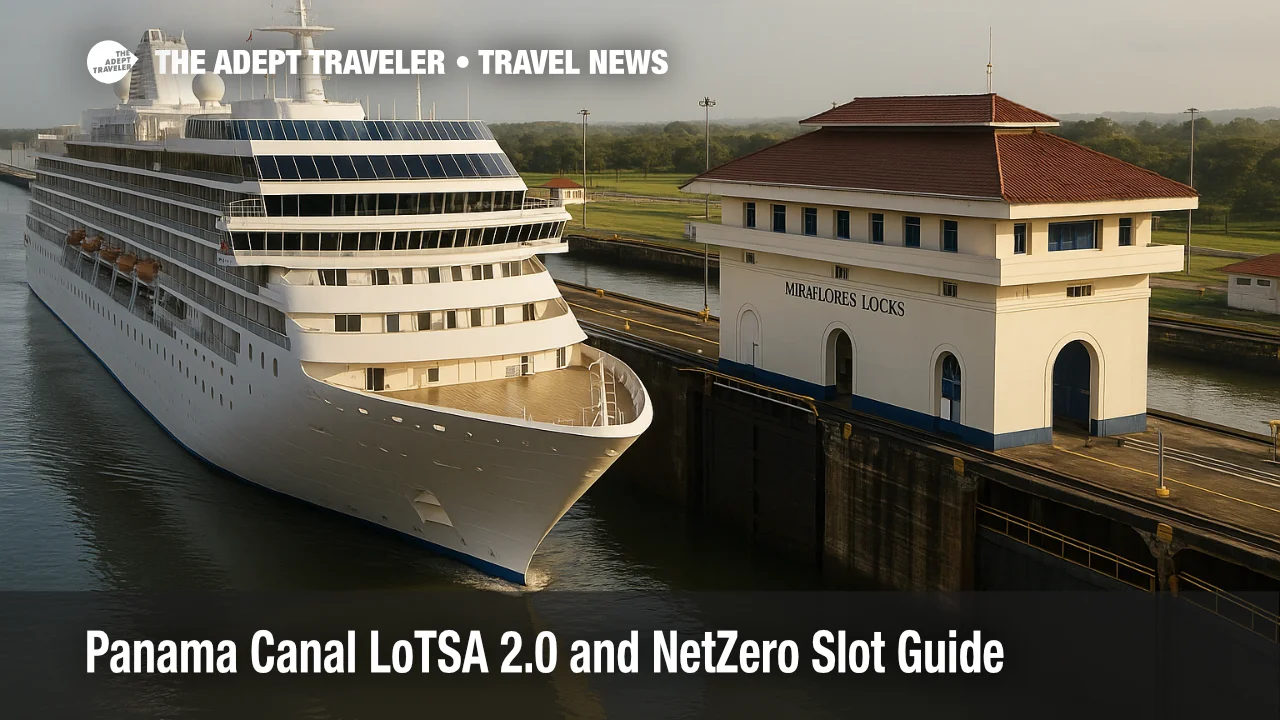Panama Canal LoTSA 2.0 and NetZero Slot Guide

Key points
- Panama Canal transits rose about 19 percent in FY2025 as drought-era limits eased
- LoTSA 2.0 formalizes long-term slot packages and sealed-bid cycles that start January 4, 2026
- A weekly NetZero Slot rewards low-emission Neopanamax ships, potentially affecting auction priorities
- Improved flow supports cruise repositionings, but ETAs can still shift around slot confirmations
- Travelers should watch operator notices for revised call times and embarkation adjustments
Impact
- Booking Windows
- LoTSA 2.0 introduces fixed cycles and sealed bids, with date changes allowed within rules that reduce last-minute scrambles
- Cruise Passengers
- Expect published ETAs to carry buffer language until the line has a confirmed transit slot
- Green Incentives
- Weekly NetZero Slot prefers qualifying lower-emission ships, which can nudge auction dynamics
- Itinerary Planning
- Choose flexible tours around Canal days and keep ship-to-airport transfers conservative
- Watchpoints
- Look for embarkation emails and app alerts in the week before transit for any time shifts
The Panama Canal's operating picture has materially improved for the 2025-2026 season. Preliminary FY2025 results show vessel transits up roughly 19 percent year over year as drought restrictions eased, while the Canal has rolled out two policy changes that matter for planning, the enhanced Long-Term Slot Allocation program known as LoTSA 2.0, and a weekly "NetZero Slot" aimed at lower-emission Neopanamax ships. Together, these shape how priority is allocated and why cruise ETAs can still shift by hours even with better daily flow.
LoTSA 2.0, in plain English
LoTSA is the Canal's long-term reservation system. The 2.0 refresh sets defined cycles and a sealed-bid process for packages that secure preferred transit dates months ahead. ACP confirmed LoTSA 2.0 on September 29, 2025, with the first cycle running January 4, 2026 through July 4, 2026, and bids due October 28, 2025 during a specified morning window in Panama. Benefits include advance access, limited free date changes with proper notice, and clearer customer-ranking continuity while a new ranking model is developed. For travelers, the point is predictability for ship operators, which reduces, but does not eliminate, timing volatility around Gatun and the locks.
NetZero Slot, what it does
ACP also introduced a weekly NetZero Slot; this is a reservation opportunity reserved for qualifying lower-emission Neopanamax vessels. It is part of a broader 2050 decarbonization plan and adds one more lever in the reservation ecosystem, effectively rewarding greener ships in a way that may influence who clears earlier when capacity is tight. While commercial cargo dominates the NetZero discussion, the rule exists alongside LoTSA and standard auctions, so cruise planners account for it when mapping their preferred windows.
Latest developments
ACP's FY2025 topline shows resilience: revenue climbed to about $ 5.7 billion as transits rebounded to 13,404, up 19.3 percent from the drought year, with LPG and container segments leading the recovery. That rebound underpins a stronger cruise repositioning season, including several first-ever ship transits highlighted by ACP. Still, ACP continues to publish operational advisories and booking-system updates, which can affect the exact hour a ship enters a lock. Travelers should treat printed Canal-day times as provisional until the line confirms its slot.
Analysis
How it works
A Canal day on a cruise is a choreography of three pieces: a long-term slot package secured months ahead (LoTSA), tactical auctions and standard bookings closer to the date, and operational advisories that may tweak sequencing on the day. LoTSA 2.0 codifies the first piece with sealed bids and defined cycles, giving operators clearer horizons for planning. The NetZero Slot folds in once per week for qualifying ships and can change the pecking order for that day's Neopanamax movements. Even with higher overall throughput than in late 2023, ACP's advisory cadence, water-management rules, and traffic separation controls still create small timing waves that ripple into cruise call times.
Daily slot posture and traveler takeaways
Daily booking availability, which was heavily constrained during the drought period, has been steadily adjusted through ACP advisories and system modifications. The practical effect for passengers is improved likelihood of a same-day full transit within the published window, but not a guarantee of the exact hour that brochures once printed by default. Plan Canal-day excursions with generous buffers, avoid tight independent airport transfers the same afternoon, and expect your cruise line's app to issue a "final" lock-entry time closer to the date.
Which cruises are affected now
ACP expects a robust cruise season with multiple first-ever transits, and major lines including Holland America, Princess, Royal Caribbean, and others continue to market full and partial transits for 2025-2026. Lines routinely annotate Panama Canal days as "transit window subject to ACP confirmation," and they can adjust call sequences around confirmed slots. If your sailing lists a precise lock entry hour far in advance, treat it as a placeholder and watch for updates in the week before transit.
Final thoughts
The Canal is healthier operationally than it was a year ago, which is good news for travelers considering bucket-list transits. LoTSA 2.0 and the NetZero Slot add structure and, for some ships, a greener path to priority, but your exact Canal-day hour is still a live operational variable. If your itinerary hinges on a tight connection or a specific shoreside booking, build cushions and keep an eye on operator messages.
